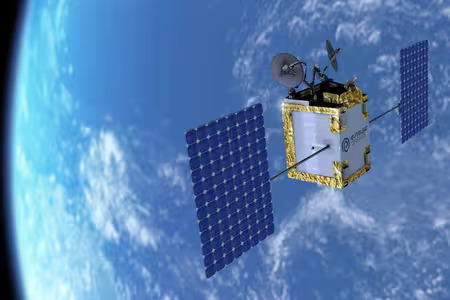During the trial, a 5G user terminal successfully connected to the 5G core via the satellite link and exchanged traffic.

Eutelsat Group, MediaTek Inc., and Airbus Defence and Space have reportedly conducted the worlds first trial of 5G Non-Terrestrial Network (NTN) technology using the Eutelsat OneWeb low Earth orbit (LEO) satellite constellation. This paves the way for widespread adoption of the 5G NTN standard, ensuring seamless interoperability between satellite and terrestrial networks, reducing costs and expanding satellite broadband access for 5G-enabled devices worldwide.
The trial leveraged Eutelsat OneWeb satellites, along with MediaTeks NR NTN test chipset and gNB technology provided by ITRI, in alignment with the 3GPP Release 17 specifications. Equipment from Sharp and Rhode & Schwarz supported the tests, while the Airbus-built LEO satellites featured Ku-band service links and Ka-band feeder links, implementing the “Earth-moving beams” concept. During testing, a 5G user terminal successfully connected to the 5G core via the satellite link, demonstrating seamless data exchange.
The integration of 5G standards across the mobile industry will allow satellite constellations to complement terrestrial networks naturally, enabling global connectivity at scale. This advancement is expected to open new opportunities across sectors, including smartphones, automotive applications, and the Internet of Things (IoT).
Arlen Kassighian, Chief Engineering Officer at Eutelsat Group, said: “These trials show the commitment of Eutelsat Group in developing and adopting new technologies, in order to provide the best possible services to our customers, in collaboration with trusted partners. 5G NTN will be a key feature of the IRIS2 constellation, and Eutelsat is at the forefront of this innovation and an active member of the ecosystem. We are proud to be the first satellite operator to demonstrate the 5G air interface working on a commercial fleet in Ku-band and paving the way for new applications in future constellations.”
Mingxi Fan, Head of Wireless System and ASIC Engineering at MediaTek, added: “As a global leader in terrestrial and non-terrestrial connectivity, we continue in our mission to improve lives by enabling innovative technology that connects the world around us, even in areas with little to no cellular coverage. By making real-world connections with LEO satellites in orbit, we are now another step closer to bring the next generation of 3GPP-based NR-NTN satellite wideband connectivity for commercial use.”
Elodie Viau, Head of Space Systems Engineering at Airbus, stated: “Demonstrating successful 5G NTN satellite connectivity using the Airbus-built OneWeb satellites not only proves the flexibility and innovative design of the satellites but opens the prospect of true global satellite broadband connectivity for 5G devices. As a pioneer in space connectivity, we are actively contributing to the development of 5G NTN, and we look forward to the next stage of further integrating satellites in our everyday lives.”













































































